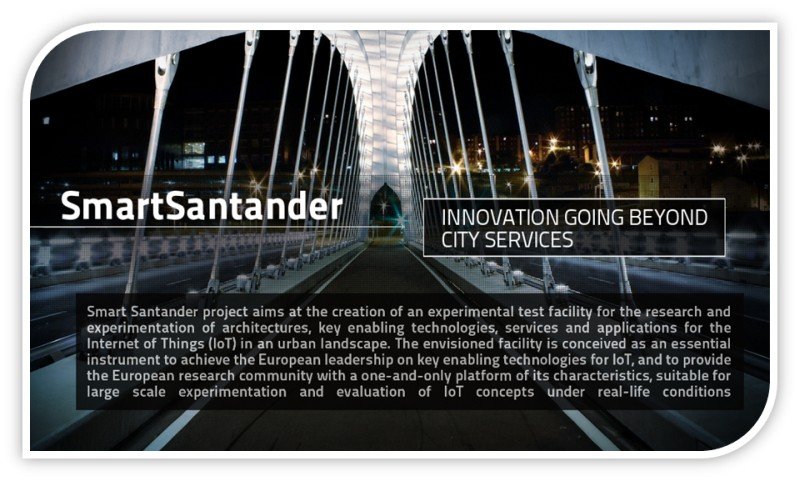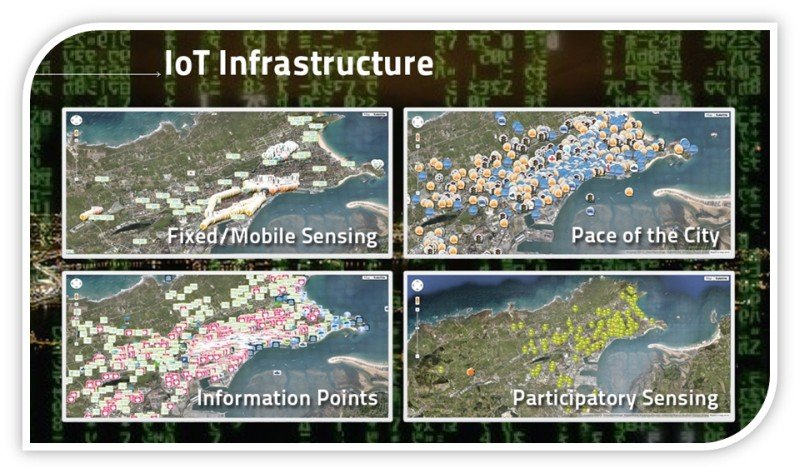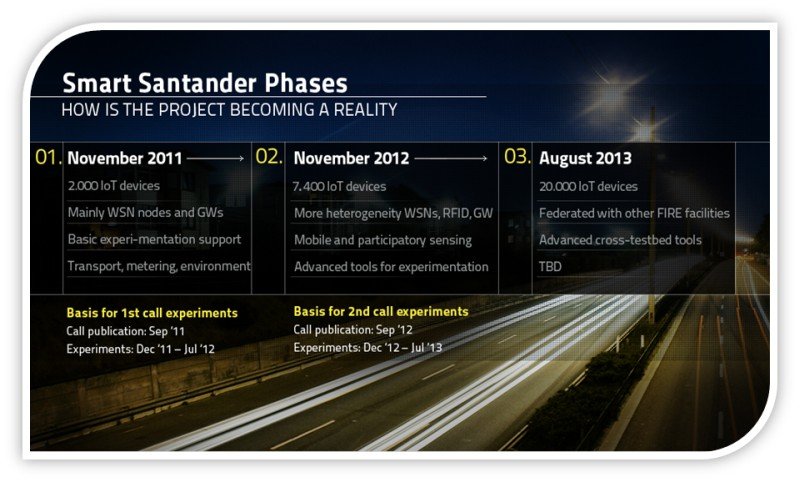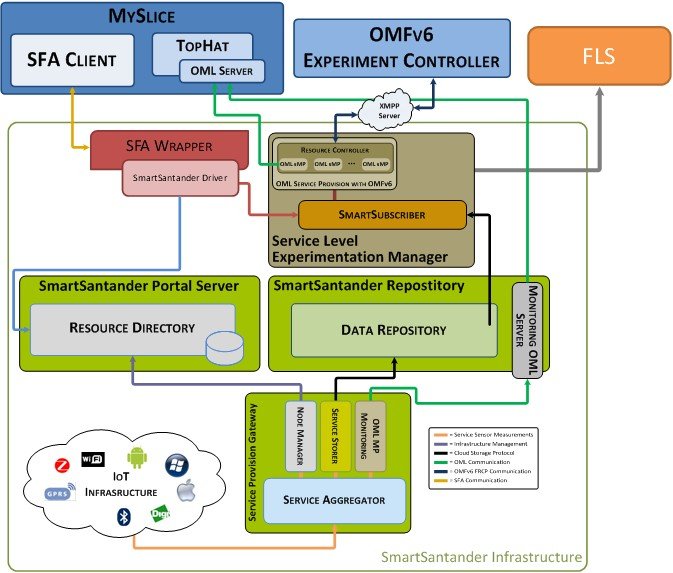What is Smart Santander?
The Smart Santander facility is a large scale smart city deployment in the Spanish city of Santander. The testbed supports two types of experiments: Internet of Things native experimentation (wireless sensor network experiments) and service provision experiments (applications using real-time real-world generated sensor data). At the moment, it is only planned to include service provision experiments in Fed4FIRE.

Smart Santander
Smart Santander services
Service experimentation on top of Santander testbed includes real-time generated information from several different services.
All this information is stored in a data repository and can be concurrently accessed once authenticated and authorised by using a web service interface. In the context of Fed4FIRE, SFA discovery and OML data gathering is envisioned.

Smart Santander services
IoT infrastructure
The Santander testbed is composed currently of around 2000 IEEE 802.15.4 devices deployed in a 3-tiered architecture:
- IoT node: Responsible for sensing the corresponding parameter (temperature, CO, noise, light, car presence, etc.).
- Repeaters: These nodes are placed high above the ground in street lights, semaphores, information panels, etc, in order to behave as forwarding nodes to transmit all the information associated with the different measured parameters. They include two 802.15.4 transceivers in order to separate the native experimentation layer from the management one.
- Gateway node (Meshlium): Device that collects the measurements from a large number of sensor nodes and uploads all this data to the Smart Santander servers through their Internet uplink.
However, the IoT infrastructure deployed around the city of Santander does not only include traditional “mota” sensors but a wider set of sensing points. In this sense, the sensor conception in Smart Santander also covers human interactions with augmented reality passive tags deployed around the city or participatory sensing.

IoT infrastructure

Participatory sensing

Augmented reality
Native Experimentation on top of IoT nodes
As mentioned in the previous slides, during the first round of Fed4FIRE open call experiments, the data originating from all these sources will be provided to the experimenters, but it will not be possible to run wireless IoT experiments.
Nodes allowing native experimentation are mainly the ones covering environmental monitoring. Both fixed and mobile sensors deployed in vehicles can be flashed over the air in a multihop fashion (MOTAP) with different programs, thus allowing the researchers to test different experiments on the deployed network. In this case, there is an exclusive resource reservation system prior to getting access to any node.

Native Experimentation on top of IoT nodes
SmartSantander phases
SmartSantander is still an ongoing project that will be finished at the end of 2013. In April 2013 there are around 10000 sensors already deployed in the city of Santander.

Smart Santander Phases
Fed4FIRE – Smart Santander integration
The scope of the Smart Santander testbed is quite different than that of the majority of Fed4FIRE testbeds. Since it does not plan to provide IoT experimentation functionalities through the federation at the moment, it does not provide typical resources as depicted in the uniform view that is given at the end of every testbed section. Instead, it allows FEd4FIRE experimenters access to the Smart Santander data repository to support smart city experimentation. Therefore a slightly different approach needs to be taken here.
SFA is used to get information about the testbed, and all corresponding nodes, including information such as GPS location and equipped sensors (temperature, light, CO, noise, parking, batterie level, acceleration, etc.)
Based on this information, experimenters can decide which information they want to retrieve from the SmartSantander Data Repository. In line with the Fed4FIRE architecture, these measurements will be provided in the form of an OML stream. To set up this stream, OMF6 will be used. It will be used in the description and provisioning of the experiments to allow the creation of real-time per-experiment RCs and their removal as soon as all resource reservations have ended. These RCs will include one or more OML sMP (the ‘s’ stands for service) which will be instructed during the configuration stage to redirect the desired OML measurements to one or more OML Servers. To support this highly dynamic automatic configuration of OML streams based on the current experimentees’ needs, a new component SmartSubscriber is being developed in Fed4FIRE.

Fed4FIRE – Smart Santander integration
Contact
More details can be found: http://www.smartsantander.eu/index.php/testbeds/item/132-santander-summary





